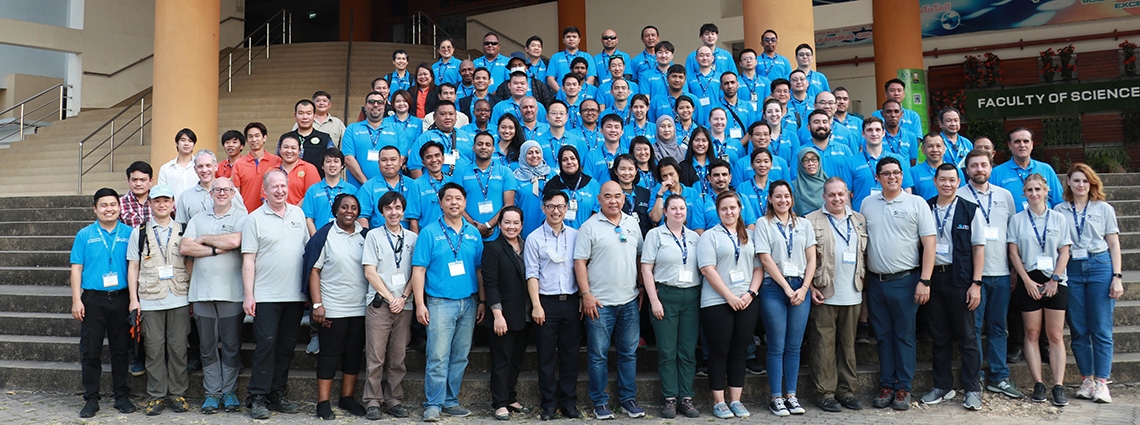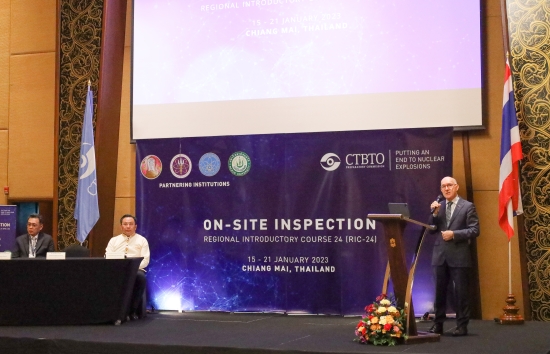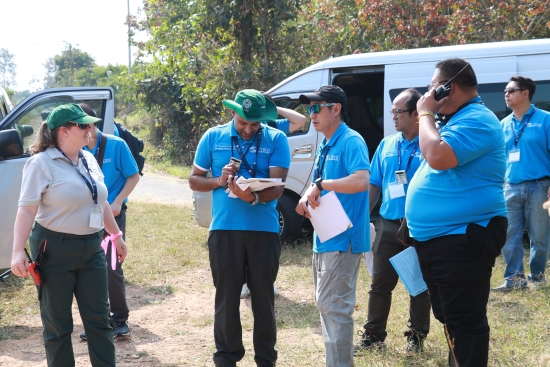CTBTO holds On-Site Inspection Regional Introductory Course in Thailand
The 24th CTBTO On-site Inspection (OSI) Regional Introductory Course - known as RIC-24 - took place in Chiang Mai, Thailand from 15 to 21 January 2023. 67 course participants representing 25 States Signatories took part in the weeklong event. The participants included geologists, seismologists, geophysicists, radionuclide and radiation monitoring experts, experts in field deployment and operational support, as well as experts in airborne position finding or visual observation. RIC-24 provided a comprehensive introduction into on-site inspection related concepts, technologies and operations, as well as field exercise activities that were conducted on the expansive grounds of Maejo University.
The key objectives of the Regional Introductory Course are two-fold: 1) to acquaint national technical experts and personnel from States Signatories of the region with the OSI regime; and 2) to broaden the pool of experts from the geographical region for participation in OSI related activities and to identify potential candidates for the CTBTO’s roster of OSI surrogate inspectors.
RIC-24 was hosted by the Government of the Kingdom of Thailand in cooperation with the Office of Atoms for Peace, the Ministry of Higher Education, Science, Research and Innovation and the Chiang Mai Province. The course kicked-off on 15 January with remarks delivered by Pemsuk Sutchaphiwat, Secretary General of the Office of Atoms for Peace, Nirat Phongsittithaworn, the Governor of Chiang Mai Province, and Robert Floyd, CTBTO Executive Secretary.
It has been a privilege for the Office of Atoms for Peace to co-host RIC-24. This is a big step forward for further enhancement of OSI capabilities and for the country’s commitment towards ‘The Nuclear-Weapon-Free World'.
Courses like this enable experts from around the world to gather and exchange ideas, build relationships and, ultimately, to move us forward on the important task of preparing for our Treaty’s entry into force.
“Here in Chiang Mai, national technical experts from the States Signatories of the South-East Asia, the Pacific and Far East geographical region will become better acquainted with the On-Site Inspection system; and, in doing so, will broaden the pool of experts from this region for participation in future OSI related activities,” Floyd added.
Training methodologies utilised during RIC-24 minimised traditional classroom presentations and prioritised the use of hands-on and team-based activities. This maximised the practical training opportunities on OSI procedures and inspection techniques through negotiation table-top exercise role playing, a base of operations location planning activity, station rotation activities on various inspection techniques and a field training exercise in which trainees synthesized and applied the concepts and competencies learned during the course.
Trainees prepared for participating in RIC-24 by completing a robust online curriculum featuring a set of newly published e-learning modules. These modules include features such as scenario-based learning, video demonstrations, branching interactions, immersive 360-degree images and a virtual field exercise activity.
RIC-24 also served as an entry point for national technical experts with expertise in OSI techniques into the new Linear Training Programme, the next iteration of the OSI training programme to be implemented in 2022 – 2025. A total of 6 participants from 5 States Signatories participated in RIC-24 as Linear Training Programme nominees.
On-site inspection in the CTBT
The Comprehensive Nuclear-Test-Ban Treaty (CTBT) stipulates that on-site inspections can only be invoked once the Treaty has entered into force. The Treaty prescribes how an inspection is triggered; how it is prepared and conducted; what techniques and procedures can be applied; which information an inspection report should contain; and what possible steps could follow the report’s examination by the Organization’s main executive organ, the Executive Council.
The CTBTO is now working to build up the OSI regime, so that the OSI capability will be available following the Treaty’s entry into force. An on-site inspection is a major operation requiring well-tuned and careful preparation and implementation. In order for it to work effectively, the CTBTO is testing all procedures and techniques of an on-site inspection in field experiments and table-top simulation exercises.
Workshops and training courses complement these efforts. On-site inspections are conducted to verify States Parties’ compliance with the CTBT. An on-site inspection is launched to establish whether or not a nuclear explosion has been carried out. During such an inspection, facts might also be gathered to identify a possible violator of the Treaty. It thus constitutes the final verification measure under the CTBT.
Only an On-site Inspection can clarify, with the highest degree of certainty, whether there has been a nuclear explosion.
"The CTBT verification regime will not be complete until we have full confidence in our ability to gather facts on the ground through a robust and independent On-Site Inspection. OSI is therefore a key asset of the CTBTO. It is the Treaty’s ultimate verification measure,” said Oleg Rozhkov, Director of CTBTO’s On-Site Inspection Division.
“While the On-site Inspection capabilities with equipment and techniques have been developed and refined continuously for more than 20 years and a training programme has advanced over the years, an OSI can only be deployed after the Treaty has entered into force,” he stressed.
3 Feb 2023
Pemsuk Sutchaphiwat, Secretary General of the Office of Atoms for Peace, addresses attendees of the 24th OSI Regional Introductory Course (RIC-24).
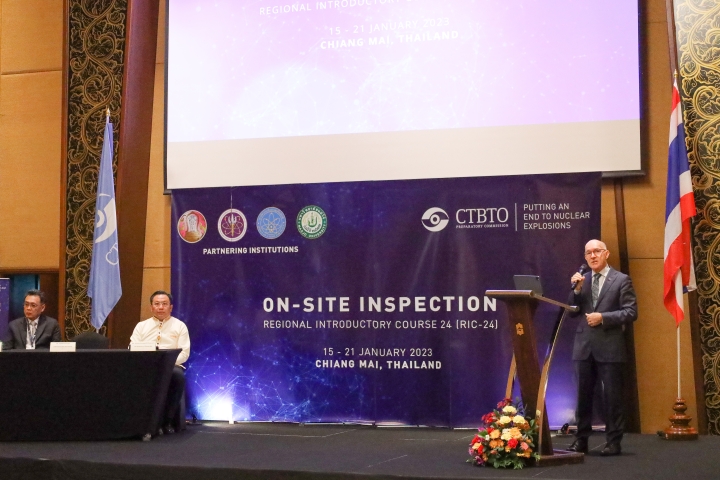
CTBTO Executive Secretary Robert Floyd speaks to participants at RIC-24.
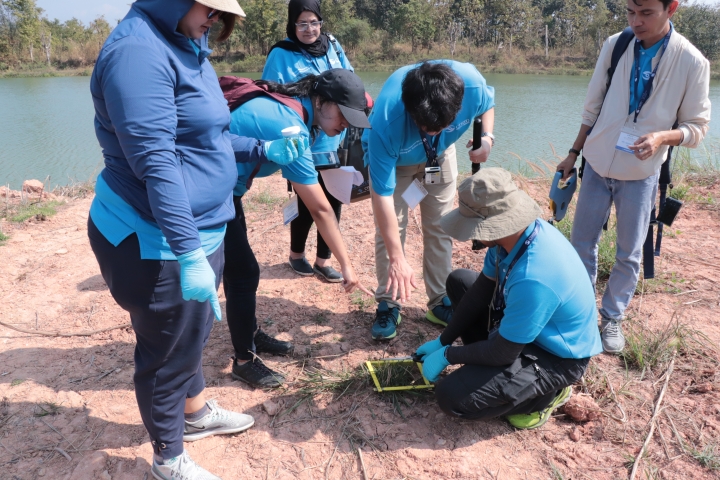
Trainees perform environmental sampling of vegetation during the RIC-24 field exercise. During an inspection, environmental sampling is used to identify radiation anomalies and narrow the inspection area.

Upon arrival at a search zone a field team performs various procedures including checking levels of radiation, verifying their location using an inspector field tablet, communications with the base of operations and in some scenarios, negotiating with an Inspected State Party representative regarding managed access provisions.
